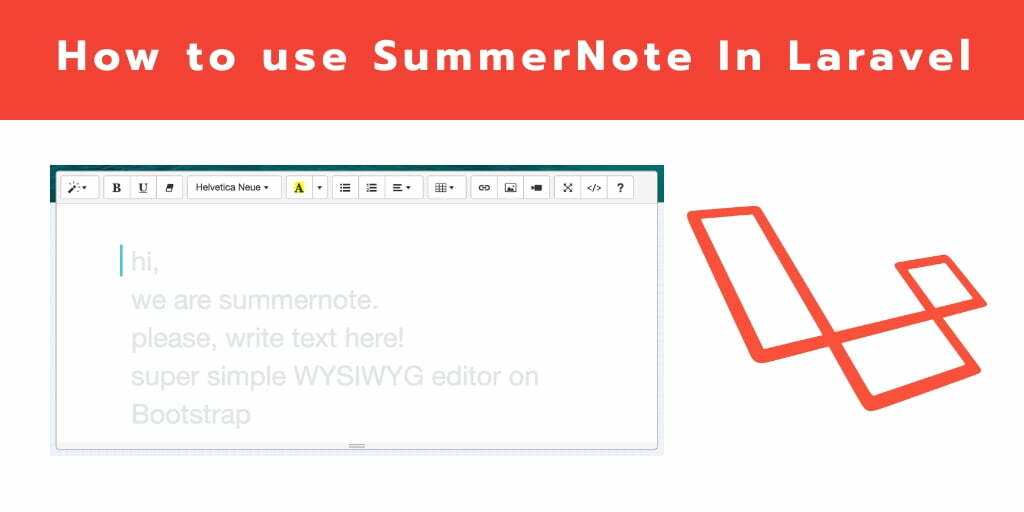Laravel summernote example tutorial, here you will learn how to use summernote in laravel apps.
This laravel summernote example guides you step by step on how to use summernote wysiwyg editor in laravel apps.
How to Use Summernote in Laravel?
Follow the below-given 7 steps and use summernote editor in laravel apps:
- Step 1: Install Laravel App
- Step 2: Add Database Details
- Step 3: Create Migration and Model File
- Step 4: Add Routes
- Step 5: Create Controler
- Step 6: Create Blade File
- Step 7: Run Development Server
Step 1: Install Laravel App
In this step, open a terminal and run the following command. This command will install or download laravel fresh application setup for implementing summernote editor:
composer create-project --prefer-dist laravel/laravel blog
Step 2: Add Database Details
In this step, Navigate to your project root directory and open the “.env” file. Then add database details into .evn file, as follow:
DB_CONNECTION=mysql DB_HOST=127.0.0.1 DB_PORT=3306 DB_DATABASE=Enter_Your_Database_Name DB_USERNAME=Enter_Your_Database_Username DB_PASSWORD=Enter_Your_Database_Password
Step 3: Create Migration and Model File
In this step, create a migration for post table and post Model in laravel app. So run the following command on command prompt:
cd blog php artisan make:model Post -m
Next, Navigate to database/migrations and open create_posts_table.php. Then update the following code into create_books_table.php file, as follow:
<?php
use Illuminate\Database\Migrations\Migration;
use Illuminate\Database\Schema\Blueprint;
use Illuminate\Support\Facades\Schema;
class CreatePostsTable extends Migration
{
/**
* Run the migrations.
*
* @return void
*/
public function up()
{
Schema::create('posts', function (Blueprint $table) {
$table->id();
$table->string('title');
$table->longText('description');
$table->timestamps();
});
}
/**
* Reverse the migrations.
*
* @return void
*/
public function down()
{
Schema::dropIfExists('posts');
}
}
Then, run the following command on command prompt:
php artisan migrate
This command will create tables in your database.
After that, Navigate to App directory and open Post.php model file. Then add the following code into Post.php model file, as follow:
app/Post.php
<?php
namespace App;
use Illuminate\Database\Eloquent\Model;
class Post extends Model
{
protected $fillable = ['title','description'];
}
Step 4: Add Routes
In this step, Navigate to the routes folder and open web.php file. Then add the following routes into web.php file, as follow:
Route::get('posts','PostController@index');
Route::post('posts','PostController@store')->name(posts.store);
Route::get('posts/{id}','PostController@show')->name(posts.show);
Step 5: Create Controler
In this step, create one controller file name PostController.php. So open your terminal and run the following command to create PostController file, as follow:
php artisan make:controller PostController
Then, Navigate to app/http/controllers and open PostController.php file. And update the following code into your PostController.php file, as follow:
<?php
namespace App\Http\Controllers;
use Illuminate\Http\Request;
use App\Post;
class PostController extends Controller
{
/**
* Display a listing of the resource.
*
* @return \Illuminate\Http\Response
*/
public function index()
{
return view('create');
}
/**
* Store a newly created resource in storage.
*
* @param \Illuminate\Http\Request $request
* @return \Illuminate\Http\Response
*/
public function store(Request $request)
{
$input = $request->all();
Post::create($input);
return redirect()->back();
}
/**
* Display the specified resource.
*
* @param int $id
* @return \Illuminate\Http\Response
*/
public function show(Post $post)
{
return view('display',compact('post'));
}
}
Step 6: Create Blade File
In this step, Navigate to resources/views folder. And create 2 blade views that named display.blade.php and create.blade.php the file inside this folder.
Then open create.blade.php file and update the following code into create.blade.php file, as follow:
<!DOCTYPE html>
<html>
<head>
<title>How To Use Summernote Editor In Laravel - Tutsmake.com</title>
<script src="https://cdnjs.cloudflare.com/ajax/libs/jquery/3.5.1/jquery.min.js"></script>
<link rel="stylesheet" href="https://cdnjs.cloudflare.com/ajax/libs/twitter-bootstrap/4.5.0/css/bootstrap.min.css"/>
<link rel="stylesheet" href="https://cdnjs.cloudflare.com/ajax/libs/summernote/0.8.18/summernote.min.css"/>
<script src="https://cdnjs.cloudflare.com/ajax/libs/twitter-bootstrap/4.5.0/js/bootstrap.min.js"></script>
<link href="https://stackpath.bootstrapcdn.com/bootstrap/3.4.1/css/bootstrap.min.css" rel="stylesheet">
<script src="https://code.jquery.com/jquery-3.5.1.min.js"></script>
<script src="https://stackpath.bootstrapcdn.com/bootstrap/3.4.1/js/bootstrap.min.js"></script>
</head>
<body>
<div class="container">
<div class="row">
<div class="col-md-8 offset-2 mt-5">
<div class="card">
<div class="card-header bg-info">
<h6 class="text-white">Laravel Summernote Example Tutorial</h6>
</div>
<div class="card-body">
<form method="post" action="{{ route('posts.store') }}" enctype="multipart/form-data">
@csrf
<div class="form-group">
<label>Title</label>
<input type="text" name="title" class="form-control"/>
</div>
<div class="form-group">
<label><strong>Description :</strong></label>
<textarea class="summernote" name="description"></textarea>
</div>
<div class="form-group text-center">
<button type="submit" class="btn btn-success btn-sm">Save</button>
</div>
</form>
</div>
</div>
</div>
</div>
</div>
<script type="text/javascript">
$(document).ready(function() {
$('.summernote').summernote();
});
</script>
</body>
</html>
Now open display.blade.php file and update the following code into your list.blade.php file, as follow:
<!DOCTYPE html>
<html>
<head>
<title>Use Summernote Editor In Laravel - Tutsmake.com</title>
<script src="https://cdnjs.cloudflare.com/ajax/libs/jquery/3.5.1/jquery.min.js"></script>
<link rel="stylesheet" href="https://cdnjs.cloudflare.com/ajax/libs/twitter-bootstrap/4.5.0/css/bootstrap.min.css"/>
<script src="https://cdnjs.cloudflare.com/ajax/libs/twitter-bootstrap/4.5.0/js/bootstrap.min.js"></script>
</head>
<body>
<div class="container">
<div class="row">
<div class="col-md-12">
<div id="showimages"></div>
</div>
<div class="col-md-6 offset-3 mt-5">
<div class="card">
<div class="card-header bg-info">
<h6 class="text-white">Use Summernote Editor In Laravel - Tutsmake.com</h6>
</div>
<div class="card-body">
<table class="table table-bordered">
<tr>
<th>No.</th>
<th>Title</th>
<th>Description</th>
</tr>
<tr>
<td>{{ $post->id }}</td>
<td>{{ $post->title }}</td>
<td>{!! $post->description !!}</td>
</tr>
</table>
</div>
</div>
</div>
</div>
</div>
</body>
</html>
Step 7: Run Development Server
Finally, run the following php artisan command to start development server:
php artisan serve
After that open your browser and hit the following URL on it:
http://localhost:8000/posts
Conclusion
Laravel summernote editor example, you have learned how to use summernote editor in laravel apps with example.
